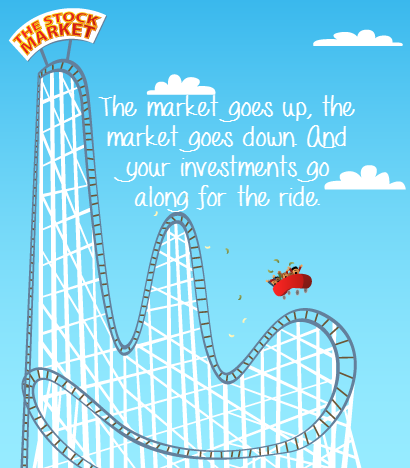In-vest’
(verb): To place money you can afford to lose in a risky venture, with the hope of making a gain.
Save
(verb): To place money you don’t want or can’t afford to lose in an account with guaranteed safety and growth, with the knowledge your money will grow.

The market goes up, the market goes down. And your investments go along for the ride. You may not realize that even one bad year – just one year of only moderate loss of capital – is extremely serious. It takes more time, a higher rate of return, and increased risk to recover. (For example, when you lose 30%, you need a gain of more than 42% to recover to where you were.) And you have no idea how long it will take you to recover… if you recover.

Year-after-year gains with no losses simply do not happen with traditional investments. And if the loss comes just before you planned to retire, it can be devastating. Because of two market crashes since 2000, nearly half of all boomers aren’t expected to have enough money to cover even basic living expenses like food and medical care, during retirement.1
Wouldn’t you agree that the return of your money is at least as important as the return on your money?
It’s interesting to note that in the tortoise and hare game scenario, the savings vehicle could earn as little as 3.5% per year and still beat the investment account.
Why Bank On Yourself Is The Answer
1. Guaranteed Growth
With Bank On Yourself, your account growth is both guaranteed and predictable, and the growth curve gets steeper every year – with no luck, skill, or guesswork needed.2
Your principal and growth are locked in. You don’t go backwards.
Contrast that with investing in the stock market. The typical investor underperforms the stock market indexes by a wide margin. In fact, for the last three decades, the typical equity fund investor averaged only 3.69% per year – beating inflation by less than 1% per year, and got two thirds less than the return of the S&P 500.3
2. No Surprise Fees Added On
With a Bank On Yourself-type policy, all fees and commissions are already included in the bottom line numbers and results you see in your policy. There are no surprises.
New rules went into effect in 2012 requiring 401(k) plans to improve fee disclosures. Yet most participants still don’t know the total fees they pay. Fees may be as low as 0.2% per year in the very largest plans, and as high as 5% in the smallest plans.4 If your plan has fewer than 1,000 participants, you are likely to be paying at least 1% in fees.5
Whether you’re investing in a 401(k), and IRA, or any other brokerage investment account, you are paying hefty annual fees. Imagine handing over as much as 5% of the value of your investment account in fees, year after year. Whether your nest egg grows or shrinks each year, you pay fees: purchase fees, account fees, redemption fees, service fees, exchange fees, management fees, and something called “12b-1” fees. (12b-1 fees let funds pass on the cost of their TV commercials to you!) Even no-load funds have fees.
An increase in fees of only 1% can wipe out 28% of your retirement savings over the next 35 years.6
3.Tax Advantages
Bank On Yourself-type plans generally allow you to get your hands on your principal and growth with no taxes due.
However, qualified retirement plans are not tax free. They’re tax-deferred. You’ll pay tax on every penny you withdraw, and if you take your money out too soon – or too late – you’ll pay tax plus a penalty. (Learn about the tax advantages of Bank On Yourself)
4. Access to Your Money on Your Terms
Not only does your money in a Bank On Yourself plan grow safely, it is also liquid. You control the money in your plan – not the government or a plan administrator.
You can use the money in your plan to fire your banker and become your own source of financing for major purchases.7
Qualified retirement plans such as 401(k)s and IRAs have more strings attached to them than a puppet. Plus, you can access your money only if you are willing to sell the investment that you’re counting on for growth. Just because you may need the money is no guarantee it will be the right time to sell your asset.
But when you use a Bank On Yourself policy to finance purchases, the money you use still grows at the same rate.
5. Lifetime Coaching and Support
A Bank On Yourself Professional can coach you throughout your lifetime with strategies for using your policy to maximize its growth.
The Bank On Yourself method is based on an asset that has increased in value every single year for more than 160 years. Learn more about it here.
Want to find out how to grow your nest egg guaranteed and predictably every year?
Request a free analysis and get a referral to a Bank On Yourself Professional to find out how much your financial picture could improve if you add Bank On Yourself to your financial plan.
REQUEST YOUR
FREE ANALYSIS!
Return to the Tortoise and Hare Game
Note: The interest rate and rate of return in this game do not represent any specific savings vehicle or investment account
- Boston College Center for Retirement Research.
- Guarantees are based on the claims-paying ability of the insurer. Learn more about the safety of Bank On Yourself
- DALBAR 2014 Quantitative Analysis of Investor Behavior
- BrightScope
- Deloitte Consulting
- U.S. Department of Labor
- Policy loans accrue interest, and they lower cash value until repaid. Death benefit is reduced by the amount of any outstanding policy loans and interest due on those loans. Excess unpaid loans may terminate a policy with tax consequences.

